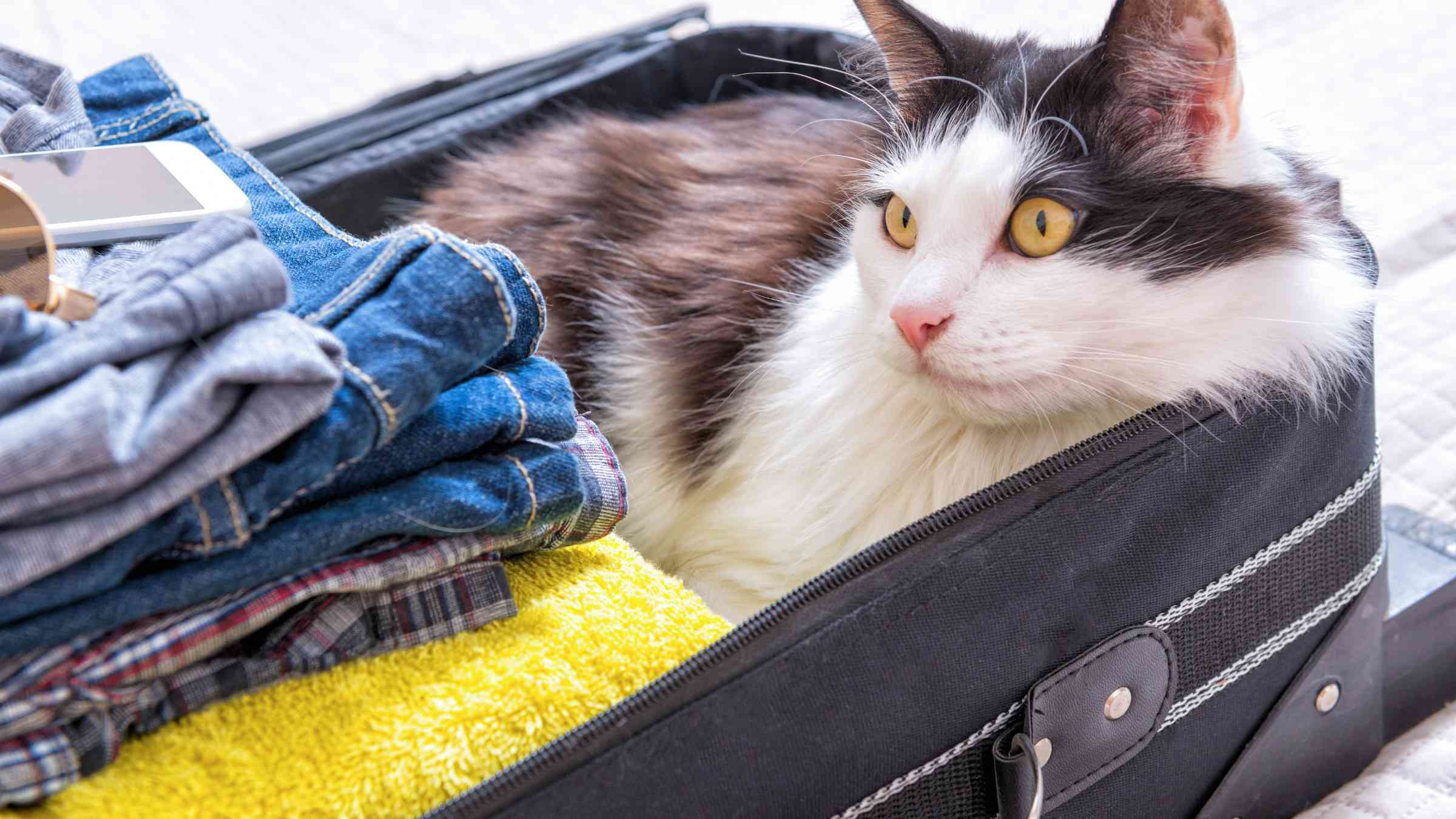As the globe gets smaller, many things that once seemed an impossibility have become fairly easy to do. Traveling with pets, particularly internationally, was once prohibitively expensive and required obscenely long periods of quarantine (I’m looking at you, New Zealand!).Things are a lot easier now, with pet passports and options for pet passage being made more accessible and more affordable. I’ll take you through some of the things you’ll need to consider before getting your fur baby all crated up. You’ll be well equipped to decide whether traveling with your pet is right for you, and how you’ll go about it if it is!
Should you travel with a pet?
One of the first things to consider is why you are taking your pet traveling and how long it’s for. This can depend largely on the type of pet you have, and then also on your pet’s stress tolerance. If it’s a short trip and would involve a lot of handling and unfamiliar places and noises, then perhaps your cat or dog is best left in the hands of a trusted pet sitter or housing facility. While a lot of dogs enjoy a road trip, other forms of travel can be a bit of an ordeal. And for most cats, traveling at all is not high on their list of likes! If it’s long-term and is more of a relocation trip, or your animal has proven to be the chillest pet on the block, then by all means… Just be sure that the travel plan is well thought-out and you’re fully resourced and read up to deal with any snafus that might arise!
Practicalities - what you’ll need

Assuming international or interstate levels of travel here, there is a variety of requirements that must be met before any animal is introduced to a country or area. A pet passport is a great place to start, as this will make any border crossing or landings go a lot more smoothly. These nifty documents will have a note of your pet’s microchip or tattoo details, as well as a record of rabies vaccinations. This means you’ll likely need to get your pet microchipped before traveling, and keep them up-to-date with their rabies vaccines. Make sure you don’t leave it until the last minute, though, as rabies needs 28 days to properly take effect. Some countries require other vaccination records too, with a few also asking for evidence of recent flea and tick treatments. This varies between countries and states so you’ll need to check out your destination’s requirements at least a month pre-departure. You can find a pretty complete list of countries and requirements here, in fact. While not all countries require a certificate of fitness for travel from a veterinarian, it’s never a bad idea to make sure they’re in the pink of health before they go through something so outside of their normal 9 to 5.
Other things to consider
Quarantine
Check out the quarantine laws of the country you’re heading to, as there may be an at-home isolation period required, as well as a boarding arrangement on entry. This can mean ten days of more with your pet kept under observation in a government facility, so make sure your plans make allowance for these kinds of entry requirements.
Accommodation
When traveling, having a pet in tow can make accommodation options a bit thinner on the ground. Do your research beforehand and stay at pet friendly hotels or motels, with reviews that verify this claim. And try to keep the time your pet will stay in the rooms without you present to a minimum. This is better for the accommodation (because scratching), and for your pet - and let’s face it, for you too, otherwise you wouldn’t have brought them along! Staying with family or friends is another good option, where you know your fur baby will be as welcome as you are.
Traveling By Car

Though dogs love a good lean out the window, with the wind blowing in their face, this isn’t the safest place for them to be. Sorry to be a killjoy but dogs and cats should ideally be secured in a carrier that is then seatbelted into place. They should also hang out in the back seat, as front seat airbags that would deploy in an emergency could do them a fair bit of damage. Another option is the harness-type seatbelts for dogs, but these haven’t been proven to be effective in keeping pets safe in the event of a crash. Lots of pets, and cats in particular, aren’t huge fans of their carriers, since they’re usually a magical teleportation device that takes them from their comfy house to the cold examination room table at the vet’s. Spending some time getting your pet used to the carrier before travel is a must, so the journey isn’t made more stressful than it needs to be. You can feed your cat in the carrier for a week or so before travel, and line it with blankets or towels that smell like home. Make sure you stop regularly for toilet breaks and general chill time on the road too. Never leave your pet unattended in the car, especially on a hot day, as conditions inside can become untenable within a little as ten minutes. Phew, that was bossy! And for the best possible road-trip job, it’s always good if someone can sit in the back to talk calmly to, and be in sniffing distance of, the carrier, so your pet is constantly reassured by the familiar presence. I volunteer as tribute!
Traveling By Boat
Lots of cruise ship lines don’t allow pets to travel with owners, but there are some that provide kennel facilities and a very few that permit pets in private cabins. This is usually just for crossings, rather than meandering along coastlines. Be sure to check well in advance. Here are a few that do allow pets, including one with special ‘canine cruises’. Be still my beating heart! For yachts or other pleasure-craft type boats, it’s a bit more free. Acclimating your pet to the boat is the first thing that should happen, and testing out a few short trips before heading out on an epic adventure. It’s impossible to predict how an animal might react to such unknown circumstances, so give them time to get used to the new surroundings and sensations in the least threatening way. Be sure to take toys and familiar blankets. All animals on board should wear a pet flotation device at all times, with a back handle. A slippery, wet, struggling kitty will slide right out of a collar, while a handle on the bag allows for ease of rescue. You can get your pets used to these lifesaving pieces of attire at home pre-trip, too, and a small dog harness works fine for a cat. Keep lots of water freely available, as the sun can beat down pretty mercilessly, if you’re lucky! There are pet sunscreens on the market too, and seasickness medications. Lastly, consider the toilet situation. Cats will need a litter tray provided, but a dog will either need to be trained to go overboard (what a trick!) or given a portable piece of astroturf to go potty on. But above all else, how adorable is the idea of a nautical kitty? Or pup? Cats, in particular, are pretty bomb at being sailors, and have been used as ship’s cats for centuries. They helped to keep the mice and rat problems down in the stores of grain needed for long crossings. Nowadays, they can probably just hang out as a passenger, rather than crew, but it’s nice to know they could earn their keep if necessary.
Traveling By Plane

And so to planes. There are a couple of options here, which depend on the carrier. A number of airlines allow small dogs or cats into the cabins, provided they are in an approved traveling carrier. Larger dogs will generally need to travel as cargo, and for some airlines this applies to all animals. This is another area where our advice is to consider the necessity of the travel and the fortitude of your pet, as it is potentially the most stressful of all forms of travel for pets. IATA claims that pets prefer the hold to the cabin, as it is dark and quiet in there, but there are other factors to think of:
- If traveling in the summer, pick morning flights, when the temperatures will not be too high. And in winter, go for afternoon flights, when the hold has had a chance to warm up over the day.
- Choose weekday flights, when all staff are working, which will mean smoother transitions.
- Go for direct flights, so there is no need for changing planes. Not only is this less disruption for your pet, it also means there is less chance of your pet being ‘lost’ like a suitcase can be, in the confusion.
- Book at a less busy time of the season, and get there early for your flight. Rushed baggage handlers can be rougher than they mean to be, adding to your pet’s stress.
- The carrier needs to be a specifically approved one, so you can check the dimensions and requirements online.
- And of course, make sure toys and blankets are provided to give your pet comfort when you can’t be with them!
Traveling By Bus or Train
Unfortunately, not all bus or train lines allow pets onboard within the US, though Amtrak is a good bet, especially with small pets. In most parts of Europe, though, you’ll have a lot more luck (most trains allow pets on, woohoo) but you’ll need to check with your chosen provider before you travel. Carriers are a good investment here too, as the presence of so many strangers in an enclosed space can be unnerving for pets. And it’s always polite to ask people before you sit next to them with your pet. There may be allergies or phobias that need to be taken into account. Or you just might find a source of constant pets and scritches for the length of your journey. Aw, yiss!
Wrapping it up
Pets can make cool traveling companions, given the right preparation and resources. You will need to do a bit of research to make sure everything is in order before you travel, and that your travel carrier is totally cool with your plus-one. Beyond that, go forth and wander! Maybe you’ll be even the next One Bike One World-type sensation. And if you don’t know who that is, you need to google this incredible cat and man bicycle adventure team ASAP. Even if only for inspiration!




